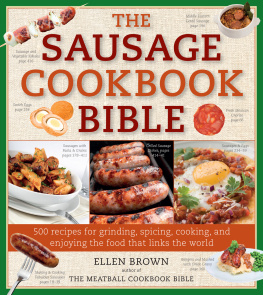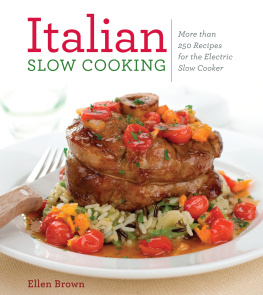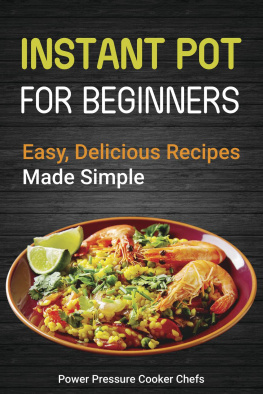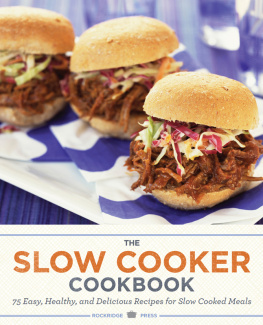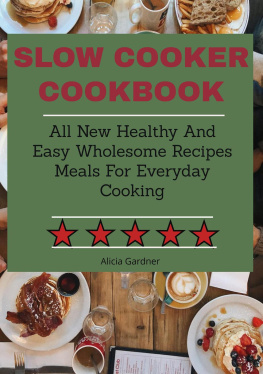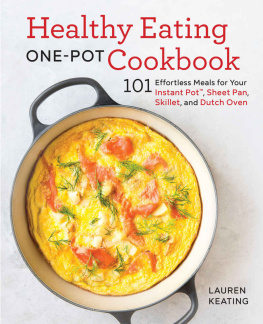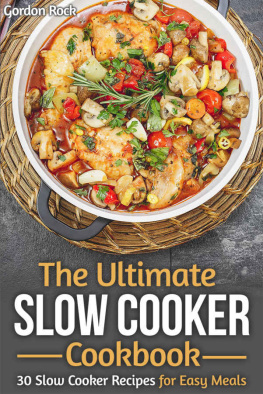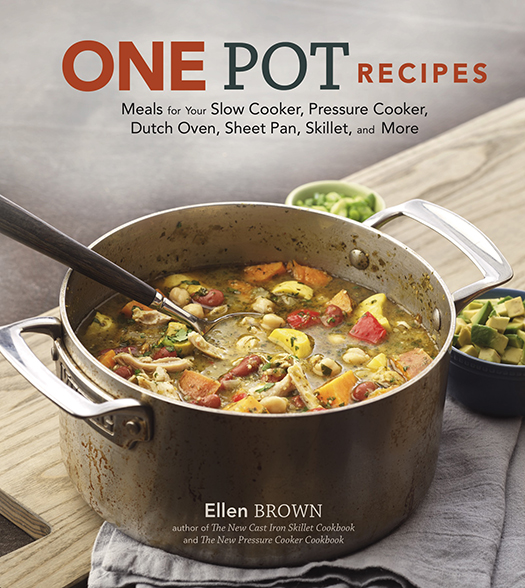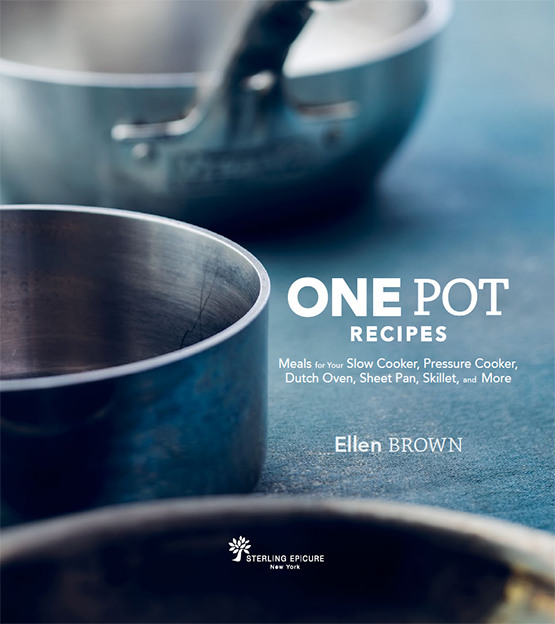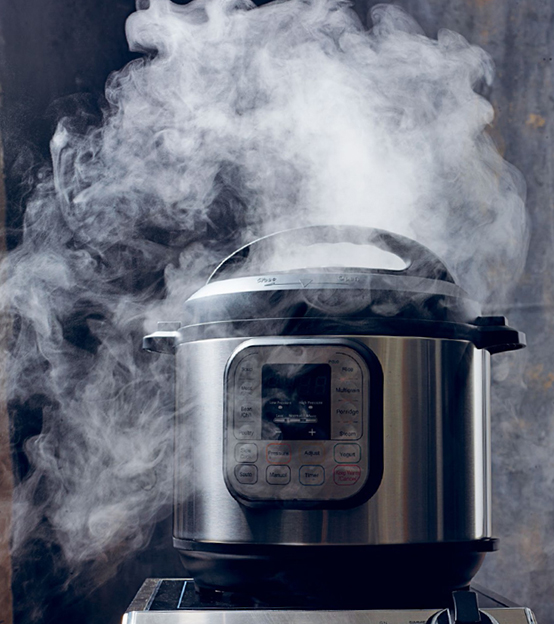STERLING EPICURE and the distinctive Sterling Epicure logo are registered trademarks of Sterling Publishing Co., Inc.
Text 2018 Ellen Brown
Photography 2018 Sterling Publishing Co., Inc.
Cover 2018 Sterling Publishing Co., Inc.
All rights reserved. No part of this publication may be reproduced, stored in a retrieval system, or transmitted in any form or by any means (including electronic, mechanical, photocopying, recording, or otherwise) without prior written permission from the publisher.
ISBN 978-1-4549-2925-3
For information about custom editions, special sales, and premium and corporate purchases, please contact Sterling Special Sales .
www.sterlingpublishing.com
Cover design by Jo Obarowski
Photography by Bill Milne
Food styling by Diane Vezza
INTRODUCTION
Benjamin Franklin wrote, Nothing can be said to be certain, except death and taxes. But Id like to add a third item to that list. Its equally certain that no one loves scrubbing pots and pans. Aphorisms become so because theyre true. Scrubbing up after a dinner is right up there on the list of dreaded events with having a root canal without Novocain.
Thats why this book was born. It offers you maximum flavor with minimal cleanup. Whenever possible the one pot or pan you use for assembling your entire dinner is covered in foil. That reduces post-dinner puttering to crumbling up a sheet of dirty aluminum foil and scoring a two-pointer tossing it into the garbage can.
If the recipe calls for cooking on top of your stove, all you need is one burner; you could successfully make these dishes on a hot plate. Other recipes start on the stovetop but are then completed with unattended cooking time in the oven, and then there are those that roast or bake while you read a book.
I have written more than forty cookbooks, but this is the first in which the recipes are divided by the one piece of cooking equipment that is needed to prepare the food rather than by the ingredients. Instead of chapters titled Poultry or Meat, youll find Slow Cookers and Sheet Pans.
Cooking with just one pot or a pan is a welcome throwback to the historic roots of American cooking. Its only been in the past century that cooking has involved more than a few pans. Thats because most folks only had one pot and one skillet, and those were probably inherited from a relative, rather than purchased new. If a meal didnt get cooked in a Dutch oven or a cast iron skillet, it probably didnt get made at all.
Using different and specialized pans for home cooking can be traced to the mid-twentieth century, when European restaurant cooking was in vogue. French chefs had scores of scrubbing hands at their disposal, so using a bakers dozen of baking sheets and saut pans to make one dish was never questioned.
One of my favorite examples of this is a traditional recipe for ratatouille, in which each vegetable was cooked individually and then combined with the others at the end. My version, which youll find on , and which includes an herbed pork tenderloin for protein, is baked on a sheet pan, and the vegetables are added to the pan sequentially, so all the ingredients reach the finish line at the same time.
Each recipe in this book gives you a complete and balanced meal that includes a protein, vegetables, and, most of the time, a starch or legume, so you dont have to make more than one recipe for dinner. Theres no flipping back and forth in the book to see if the flavor of the side dishes youve selected will be harmonious with the entre. Theres no guesswork involved, and everything is ready simultaneously, because the entire meal is prepared in one pan or pot.
Both old and new concepts underlie many of these dishes. For example, in , which is devoted to cooking on sheet pans, youll find methods that go back to classic French cuisine, such as en papillote, which involves steaming a dish in a paper or aluminum foil pouch. Other recipes in the book would enrage the most classic Italian cooks, such as a dish in which the pasta is actually cooked in the sauce. The result? Pasta that really tastes better, because it has inherent flavor, rather than merely serving as a base carrier for a topping.
In addition to five chapters that feature everyday pots and pans, two focus on electric appliances. One is the slow cooker, which you can now find in just about as many kitchens as the coffee pot; both have a household penetration of more than 90 percent. The Slow cooker is modeled after the antique bean pot, which was nestled into the embers of the fire to cook beans overnight. The modern electric slow cooker first gained fame in the early 1970s when women entered the workforce in large numbers.
The other appliance is a lightning-speed version of the slow cooker, an electric pressure cooker best known as the Instant Pot. In I give directions for both electric and stovetop pressure cookers, because, as a Pleistocene Person, I still like the ability to control the level of heat by turning a knob on my gas range. Stovetop models have been improved with myriad safety features during the past decade, so there should be less anxiety when using them.
So venture forth to join the ranks of those of us released from the tedium of cleaning up. Regardless of your age or cooking abilities, youll never have to scrub more than one pot when you cook from this book.
Happy cooking!
Ellen Brown
Providence, Rhode Island
chapter 1
Instant Pots and Pressure Cookers
No appliance has undergone a renaissance like the pressure cooker, especially Instant Pot, the latest electric version. While pressure cooking as a method was introduced in the seventeenth century, it wasnt until the twenty-first century that a machine was devised to deliver the primary benefit of literally cooking under pressure: getting a nutritious meal on the table in a matter of just a few minutes.
In the United States busy women adopted the pressure cooker in droves during World War II, when so many of them worked outside the home, and almost half of all homes in the 1950s used a pressure cooker on a regular basis. But this number plummeted as postwar cooks looked to the convenience of frozen foods that were reheated in the oven or, later, nuked in a microwave.
While electric pressure cookers were patented in 1991, it was the 2009 introduction of the Instant Pot that did for pressure cookers what Crock-Pot did for slow cookers. The new generation of pressure cookers is totally user-friendly, with tons of built-in safety mechanisms; the most important of which ensures that the pressure cooker will not turn on unless the lid is properly secured. Sales soared because cooks trusted the electric pot, and even stovetop models are regaining favor.
The father of the pressure cooker was a French physicist Denis Papin, who made his reputation in the 1670s for his studies of steam and how to best use it. While working in London a few years later in the early 1680s, he prepared a whole meal for members of the Royal Society to show how food could be cooked much faster if the boiling point of water is raised by trapping its steam in a tightly closed pot.



